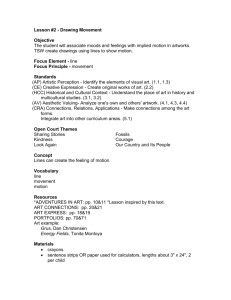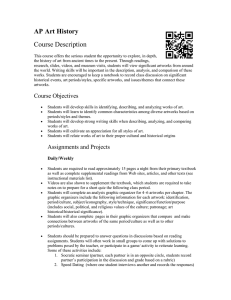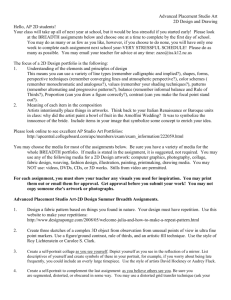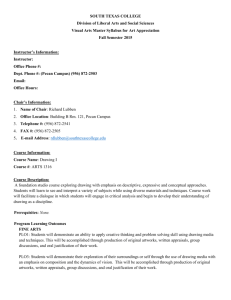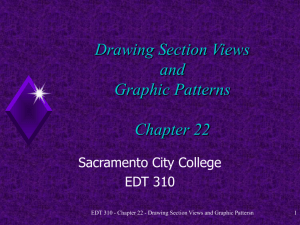Drawing 2 Syllabus
advertisement
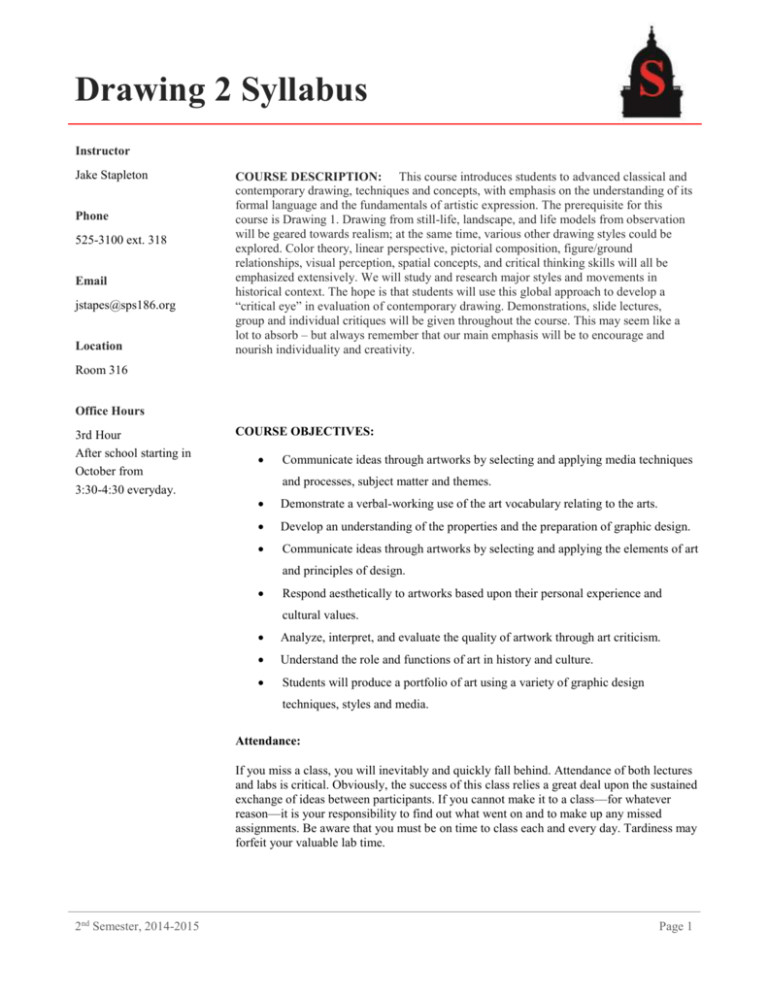
Drawing 2 Syllabus Instructor Jake Stapleton Phone 525-3100 ext. 318 Email jstapes@sps186.org Location COURSE DESCRIPTION: This course introduces students to advanced classical and contemporary drawing, techniques and concepts, with emphasis on the understanding of its formal language and the fundamentals of artistic expression. The prerequisite for this course is Drawing 1. Drawing from still-life, landscape, and life models from observation will be geared towards realism; at the same time, various other drawing styles could be explored. Color theory, linear perspective, pictorial composition, figure/ground relationships, visual perception, spatial concepts, and critical thinking skills will all be emphasized extensively. We will study and research major styles and movements in historical context. The hope is that students will use this global approach to develop a “critical eye” in evaluation of contemporary drawing. Demonstrations, slide lectures, group and individual critiques will be given throughout the course. This may seem like a lot to absorb – but always remember that our main emphasis will be to encourage and nourish individuality and creativity. Room 316 Office Hours 3rd Hour After school starting in October from 3:30-4:30 everyday. COURSE OBJECTIVES: Communicate ideas through artworks by selecting and applying media techniques and processes, subject matter and themes. Demonstrate a verbal-working use of the art vocabulary relating to the arts. Develop an understanding of the properties and the preparation of graphic design. Communicate ideas through artworks by selecting and applying the elements of art and principles of design. Respond aesthetically to artworks based upon their personal experience and cultural values. Analyze, interpret, and evaluate the quality of artwork through art criticism. Understand the role and functions of art in history and culture. Students will produce a portfolio of art using a variety of graphic design techniques, styles and media. Attendance: If you miss a class, you will inevitably and quickly fall behind. Attendance of both lectures and labs is critical. Obviously, the success of this class relies a great deal upon the sustained exchange of ideas between participants. If you cannot make it to a class––for whatever reason––it is your responsibility to find out what went on and to make up any missed assignments. Be aware that you must be on time to class each and every day. Tardiness may forfeit your valuable lab time. 2nd Semester, 2014-2015 Page 1 Late Work: I will accept late work once. I will give you feedback on late work, but the highest grade you will receive will be a C. Handing in work late deprives you of critical feedback from the class. It also robs your peers of the opportunity to develop their ability to talk about your work. Therefore, it is imperative that work be ready for discussion at the specified time. If you know you will miss a discussion session, you must see me ahead of time to make some other arrangements. Grading: As noted above, grades are based on the projects you produce as well as upon your participation in class--which includes showing up, being attentive to your own and others’ work, and just generally being prepared to get things done when you arrive. The specific breakdown of your grade is as follows. • Daily Participation 40% • Final Projects 60% Evaluation of artwork is a tricky and often subjective business. However, you can expect the following objective criteria to be used in the grading of your ceramics work. • Technical. Do your design pieces show craftsmanship? Is the subject matter clear? Have materials been handled in a consistent, considered manner? • Formal. Do your design pieces employ visually effective strategies to convey the content? Characteristics such as texture, balance, form, etc. • Intentional. Assuming that you are attempting to convey something––some idea––do the above mentioned technical and formal strategies employed in your prints effectively together to communicate that intended meaning? Lab Fees $20.00 per class. Fees will help update the current graphic design lab. Allowing us to update equipment, programs, and add new ones. Plagiarism Plagiarism can involve not only written work but also artwork. No one is allowed to use someone else’s plate to complete an assignment. In short, your work is your property and visa versa. Plagiarism is a form of cheating. Any time a student uses someone else's work and does not give that person credit, it is plagiarism. Anyone who plagiarizes will receive an “F” on the assignment. Safety You also must be aware that misuse of equipment or use of damaged equipment can create the risk of serious injury, and expensive damage. You may be liable for damage or injury resulting from such use. Failure to be alert to safety problems, or to report them, may have serious consequences for you or others. 2nd Semester, 2014-2015 Page 2 2nd Semester, 2014-2015 Page 3



